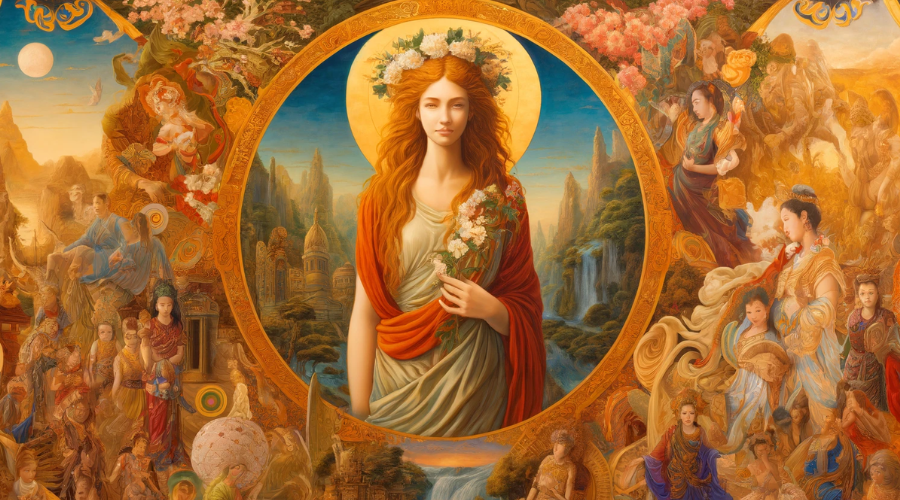The Best Artwork Depicting Roman Goddess Venus

Venus, the Roman goddess of love, beauty, and fertility, has endeared herself to artists for centuries. As the counterpart to the Greek goddess Aphrodite, she embodies the ideals of feminine beauty and sensuality. Her influence spans across various art periods, inspiring masterpieces that celebrate her divine allure.
In Roman mythology, Goddess Venus was not only a symbol of physical beauty but also a representation of love’s power and the fertility of nature. She was often depicted as a stunningly beautiful woman, sometimes emerging from the sea or surrounded by symbols of love like doves and roses.
Her significance in art history cannot be overstated. From ancient sculptures to modern paintings, her image has been a constant source of inspiration. Artists have sought to capture her essence, exploring themes of beauty, love, and the human condition through her depiction.
In this article, we will journey through the world of art to explore the best depictions of Venus from different cultures and periods.
Ancient Roman Art
In ancient Roman art, Venus, the Roman Goddess of Love, was a prominent figure, often depicted in statues and reliefs that showcased her divine beauty and grace. As the embodiment of love and fertility, she was a favorite subject among Roman sculptors who sought to capture her timeless allure in marble and bronze.
One of the most famous representations of her from this period is the Venus de Milo. Although it is a Greek statue, created around 150 BCE, it was highly revered in Rome and remains one of the most iconic depictions of the goddess. The statue is celebrated for its exquisite craftsmanship and idealized portrayal of the female form. This particular statue stands as a testament to the skill of ancient sculptors and their ability to convey beauty and sensuality through stone.
Another notable example is the Venus of Arles, a Roman marble statue from the 1st century BCE. Discovered in the ruins of the ancient theater in Arles, France, this statue portrays the goddess in a graceful contrapposto stance, draped in a flowing robe. This statue exemplifies the Roman adaptation of Greek artistic traditions, blending idealized beauty with a sense of naturalism.
Roman frescoes also featured her, often depicted in scenes that highlight her role as the goddess of love and beauty. In the ancient city of Pompeii, numerous frescoes and mosaics illustrate this goddess in various contexts, from domestic settings to mythological narratives.
These artworks provide a glimpse into how the Romans revered this particular deity.
Renaissance Era
The Renaissance era marked a revival of classical themes and an exploration of human beauty and emotion. During this period, artists created some of the most iconic depictions of the goddess of love and beauty, drawing inspiration from ancient Roman art and mythology.
One of the most celebrated works from this era is Sandro Botticelli’s “The Birth of Venus”. Completed in the mid-1480s, this painting depicts the goddess emerging from the sea on a shell, symbolizing her birth.
The painting is renowned for its graceful composition and ethereal beauty. Botticelli’s use of flowing lines and delicate colors captures the essence of divine femininity, making it one of the most famous images in Western art.
Another notable Renaissance work is Titian’s Venus of Urbino. Painted in 1538, this oil painting portrays a reclining nude figure, gazing directly at the viewer. The artwork is celebrated for its sensuality and the richness of its colors.
Titian’s masterful use of light and shadow enhances the softness of her skin, creating a sense of intimacy and realism. This painting exemplifies the Renaissance fascination with the human form and the exploration of beauty.
The Renaissance era also saw the creation of numerous sculptures inspired by classical antiquity. For example, Antonio Canova’s “Venus Italica” (though created in the early 19th century, it embodies the Renaissance spirit) is a marble sculpture that portrays the goddess in a modest, yet elegant pose.
During this period, artists not only revived classical themes but also infused their works with a sense of individualism and expression. Enthusiasts can learn more about Roman Goddess Venus here.
Baroque Period
The Baroque period brought a new level of drama and dynamism to art, and the goddess of love and beauty was a frequent subject. Artists of this era emphasized movement, emotion, and contrast, creating powerful and captivating depictions.
Peter Paul Rubens, a master of the Baroque style, created several notable works featuring her. One of the most famous is “Venus and Adonis”. This painting captures a poignant moment from mythology, with Adonis preparing to leave for the hunt as she tries to dissuade him.
Rubens’ use of vibrant colors, fluid forms, and intense emotions exemplifies the Baroque fascination with drama and sensuality. The goddess’s figure is voluptuous and dynamic, embodying the Baroque ideal of beauty and vitality.
Artemisia Gentileschi, one of the few prominent female artists of the Baroque era, also explored themes of love and beauty. Her painting “Cupid and Venus” portrays the goddess with her son Cupid, showcasing her talent for capturing complex human emotions and interactions.
Gentileschi’s work often includes strong, assertive female figures, reflecting her unique perspective and experiences as a woman in a male-dominated art world.
The Goddess Venus in Different Cultures
The deity of love and beauty, known as Goddess Venus in Roman mythology, has been depicted in various ways across different cultures, each adding unique elements to her portrayal.
In Indian art, the goddess Lakshmi shares many attributes with her, symbolizing beauty, wealth, and prosperity.
Traditional Indian paintings and sculptures often depict Lakshmi with similar attributes such as the lotus flower, symbolizing purity and beauty. This cultural parallel highlights how the themes associated with Venus transcend geographical boundaries.
Modern global pop culture frequently blends these diverse influences.
African art has its own unique interpretations. For instance, Yoruba mythology features Oshun, the goddess of love, beauty, and fertility. Oshun’s depictions in African sculptures and masks often highlight her nurturing and protective qualities, echoing the themes of love and fertility associated with this Roman Goddess.
For those wanting to learn more about ancient goddesses, judithlaura.com is a good read. There’s plenty of deities from other cultures, as well as more spiritual guides.
Even in modern times, references to goddess Venus can be found across various forms of media such as literature, films, fashion, and popular culture icons inspired by classical mythology. The enduring legacy of depicting Venus transcends traditional art forms into contemporary expressions that continue to celebrate themes related to love and beauty.

